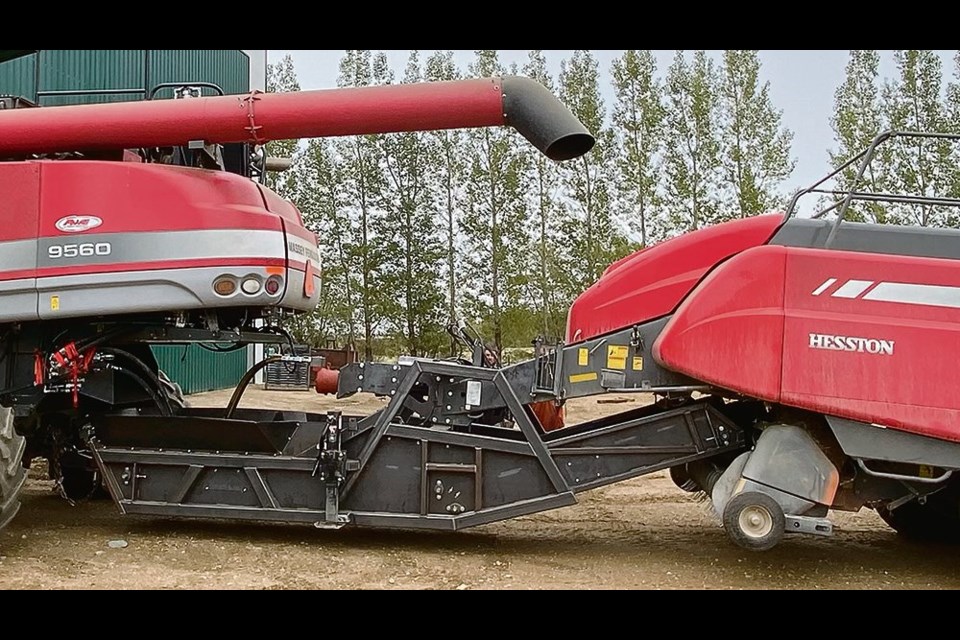MELFORT — Before Tyler Spencer, an engineer at T.W. Enterprises in Melfort, designed Ian Thorson’s combine/baler/combo, he reviewed a lot of information about previous successful and failed examples.
His instructions for others? Just get it right the first time.
The project was originally going to tap into the back of a new Fendt Ideal combine, but they backed off and switched to Massey because it was simpler, said Spencer in a phone interview.
“Ian had stated it would be acceptable to hit half the normal combine efficiency in the field, because he was doubling two processes at the same time,” said Spencer, who was born and raised at Kinistino not far from Thorson’s farm.
Spencer said his goal in linking a baler to a combine was to make it work reliably at four miles per hour in the field.
Spencer laughs, “I’m from a third-generation farming family. I’ve heard all the cussing about them darned engineers and what do they know. So, I didn’t want to be one of those darned engineers.”
They chose a used Massey Ferguson 9560 combine and a used Massey Ferguson Hesston 2270XD baler for the project.
Math was the next task. How much redundant power did the combine have once the spreader and chopper were removed? Spencer balanced power availability from the combine against power demand of the baler. The math worked out, so plans proceeded to develop the all-hydraulic baler drive. The baler needed 150 horsepower to run at full capacity and produce good bales.
Spencer said they pulled the full 150 -h.p. at 1,000 r.p.m. off the back of the combine. There was actually extra power available with the spreader and chopper removed. Spencer says they calculated that the total redundant power available from the combine was between 180 and 200 h.p. He adds that this was not a quick build. Because of pandemic shipping delays, they had to wait up to 18 months for some parts.
“Most of the combines we considered used chains and belts to drive their spreaders and choppers. The Massey combine is about three-quarters hydraulic, so that simplified things.”
He says once all the parts arrived, everything bolted together just as planned.
“The biggest challenge was where to mount this enormous pump and reservoir. We got a lot of help from High Power Electric in Prince Albert (Sask.). The 9560 has a convenient platform with a big open space right where the spreader and chopper had been, so that’s where we put the reservoir. We took out all the cross members and deck panels. That gave us a big open void. We re-engineered all those components to match the same strength they had originally. Our whole system is a bolt-in. We can put the combine back to original. No cutting or welding.”
Once the combine modification was complete, the missing link was next step. Design a conveyor to move straw and chaff back to the baler.
“We really direct the flow to control the material. There’s a shroud on the combine where the chopper spreader used to be. We can make a full turn and still have all the material drop onto the conveyor. Our conveyor has two belts and it’s powered by hydraulics. It brings the residue right to the baler mouth. There’s a shroud to make sure everything goes straight in and gets dropped behind the tines. About 98 percent of the material enters the baler. The last little bit gets airborne into the sky,” Spencer says.
“Running all the hoses was tricky because your turn radius is difficult with that conveyor and baler behind you. With autosteer, we set it up so you do every other pass with the combine.”
Most early combine/baler designs had a problem at the point where the conveyor linked to the back of the combine. Spencer says a number of these commercially built systems shoot the residue from the combine straight into the baler, which must be very close to the combine.
He says they chose to use a conveyor because it gave the operator better control over the flow and speed. If there’s plugging, the volume of residue can be adjusted hydraulically. All conveyor and baler functions are monitored from the cab, including performance of the hydraulic system.
“Connecting the conveyor cart to the combine was tricky. It was never intended to pull a baler. The rear axle tips back and forth. We designed a hitch system that’s very similar to a tractor. These combines have a hitch on back to pull a header. We utilized that and came under the axle and forward with some heavy framework. The entire axle supports this hitch.”
Spencer says while it might seem like a lot of extra stress on the combine frame, “you have to remember that the axle only sees the tongue weight of the conveyor machine. The biggest stress is passed on to the framework.”
Spencer says there was also a lot of human stress, as the team pondered what might go wrong on the maiden voyage.
“He took delivery the night we finished final touches in the shop. He drove it home in the dark that night. He took it right into the field that night and made several passes in the dark. That was the first time the machine saw a field. We made a couple adjustments the next morning and then he got on with his harvest and baled almost 1,300 bales.
“My favorite part of this whole project is that we can combine at four mph and bale straw at the same time.”
Spencer says Massey is probably the easiest brand to use because of the simplicity. Every type of combine has its own challenges when it comes to figuring out where to steal 150 h.p.

